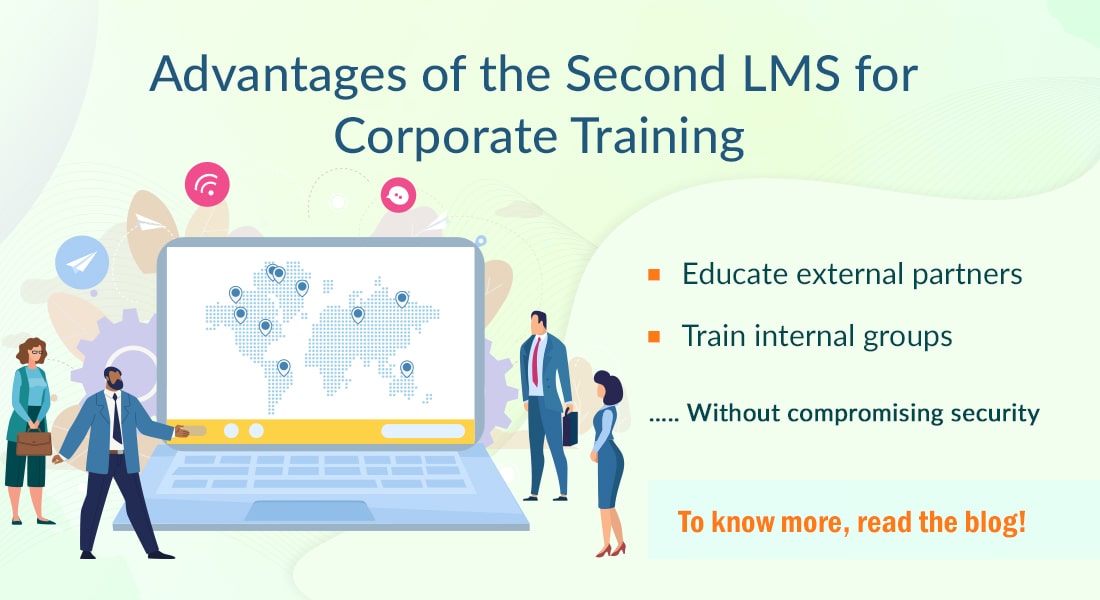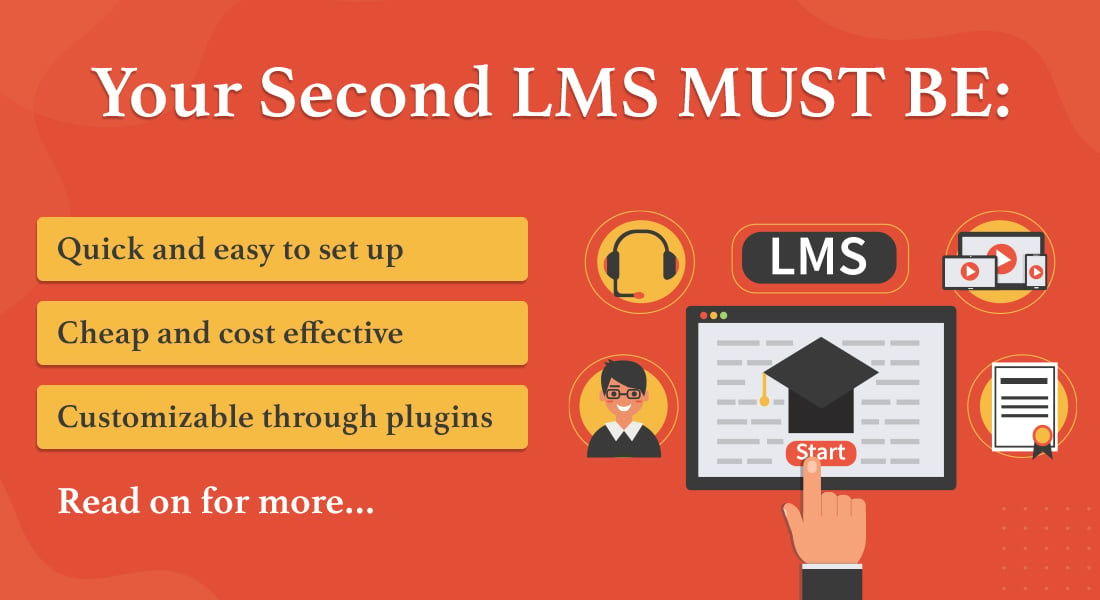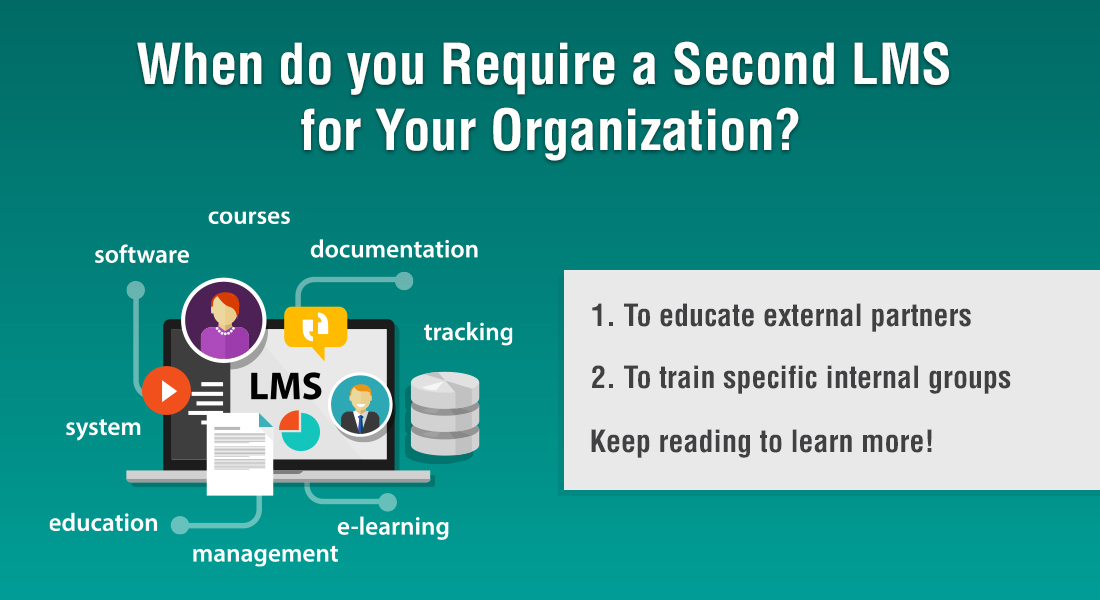Do You Have a Lean, Mean Second LMS? Do You Even Need One?

The Learning Management System (LMS) is an integral part of training implementation in any organization. It hosts eLearning courses and other digital assets too. It is also used for tracking, analyzing, and reporting learning activities in online, offline, and blended learning programs. The LMS also streamlines different training programs and provides a common hosting and reporting hub. So, it is very important to select the right LMS for your organization. And that takes a lot of planning.
Are you ready to choose the right Learning Management System?
Your organization probably has a primary LMS that takes care of all your workplace training needs. But we, in the eLearning industry, are witnessing this trend of organizations opting for a secondary LMS – especially if they have a lot of training for external partners and customers.
If you are in the same boat, a second LMS is just what you need to help streamline your varied and distinct corporate training needs. Organizations have been using an additional LMS for quite some time now to:
- Train specific internal learner groups
- Train customers, vendors, dealers
- Sell online training programs
- Provide better IT security
- Protect proprietary content
Let’s now dig a little deeper into the possibilities and advantages of a second LMS.
Why a Second LMS?
A second LMS serves two major purposes – educate external partners and train specific internal groups. Let’s explore for each the need for exclusive training requirements, why you can’t host this training on your existing LMS, and the solution offered by a second LMS.
1. To Educate External Partners
If you’re a training manager, you understand the importance of educating your customers and business partners. Educating the end users of your products/services and your investors will help your organization build long-term relationships with them. This will, in turn, help your organization achieve its business goals.
Must-Have Features for Your Second LMS
- Easy set up
- Multi-plugin support
- High engagement
- Customized reports and analytics
- Cost effectiveness
Educating customers will help them use your products the way they were meant to be used. This will also help with your compliance requirements as you provide user with safety guidelines. You can also offer the latest information about your products/services which will make your consumers and partners invested in them.
This will also reduce customer support calls as they can access the information, they need anytime, anywhere. Paid courses can also be hosted on the LMS for consumers or external partners wanting to take their understanding a step further.
Why can’t you use your existing LMS to educate external partners?
- Specific authorization restrictions don’t allow external users to access the LMS.
- Costs can become prohibitive when you try to create another section in your existing LMS to educate external partners.
- There is a risk of security breaches of confidential data when external partners are given access.
How does the second LMS help?
- Offers easy navigation for external partners through simple and user-friendly features
- Caters to specific training requirements through customized training workflows
- Keeps customers and business partners up to date by providing them latest information
- Provides customized information to different groups of external partners (through cohorts), ensuring confidentiality
- Shares customized reports with customers and business partners
- Provides free or paid training based on requirements
- Offers an automated process to sell courses
2. To Train Specific Internal Groups
Going for a second LMS will make sense if your organization has several different large groups of internal learners, each group with very different corporate training needs. For example, Sales Training would require customized training for your internal sales teams and just-in-time training and training on-the-go for sales reps in the field; Compliance Training would require training for all employees, monitoring and tracking training status.
How does the second LMS help?
- Offers specialized training workflows for each group
- Provides customized reports for specific training groups, making analysis easier and simpler
- Offers scope for gamification and higher engagement
- Offers ‘single sign-on’, so learners don’t have to authenticate each time they access the training
What Should You Look for in Your Second LMS?
We’ve discussed the ‘Why’ of a second LMS. Now here are the top 5 features you should look for in your second LMS.
1. Easy Set Up
Since your primary LMS would take care of most workplace training requirements, the secondary LMS should only include features that serve its purpose. The secondary LMS should:
- Be easy to set up, and be up and running in a week or less
- Have all the basic and required features with no bells and whistles, making it simple to use
- Allow customization (of workflows, etc.) to be added later
2. Multi-Plugin Support
The second LMS should seamlessly integrate with external plugins, making it multifunctional. It’s crucial to determine the extent to which your second LMS supports external plugins. Practically, this means the alternate LMS should:
- Be able to flexibly integrate itself with external applications – such as Zoom, PayPal
- Allow features to be added or deleted based on your requirements
- Allow customization of applications using plugins
3. High Engagement
Considering its purpose, your secondary LMS should be high on engagement – to educate your external partners in interesting ways, and your internal learning groups to value and enjoy their learning. So, your second LMS should support:
- Gamification elements – Scores, achievements, reward points, and leaderboards to encourage continuous learning.
- Microlearning and Mobile Learning – Making courses accessible on learners’ chosen devices and at a time of their convenience, and to reinforce learning.
- Customized Training – Allowing the creation of specific learning paths based on job roles, user groups, training type, and so on.
Microlearning & Mobile Learning: How Far, How Near?
4. Customized Reports and Analytics
Tracking course completion status and generating reports becomes easy. For example, while your sales managers might need monthly reports on the progress your sales reps, the HR team might need half-yearly reports on the status of compliance training programs.
Here are some examples of customized reports:
- Individual performance reports
- Country-wise team reports
- Monthly and quarterly training progress reports
- Automated monthly training progress reports sent to customers’ email addresses
Pro Tip: You can blend the multi-plugin support feature with custom reports and incorporate learning analytic tools or applications for more detailed reports. External applications can deliver in-depth and advanced learning analytics such as predictive (what the learner can possibly do next) and prescriptive (what should be done to support/counter predicted action) analytics.
5. Cost Effectiveness
A major reason for organizations opting for a secondary LMS is to save cost. Your secondary LMS, of course, should be a lot cheaper than your primary complex LMS. How can you ensure this?
- Limit its features to simple built-in ones.
- Use in-built functions for most tasks, customizing only where necessary.
- Opt and pay only for the required features, avoiding those that you do not need and may never use.
Let’s look at what we mean by required features with a few examples. Remember, even these features can be turned ‘on’ or ‘off’ according to your needs.
- Keep the ‘multilingual’ feature on if you wish your users in different geographical locations to access courses in multiple languages.
- Turn off the video, audio, and chat functions if you are going to use the secondary LMS only as a repository of content.
- Pay only for the domains you need. Once the goal is achieved, and you no longer need a specific domain, ask your vendor to remove that domain altogether.
These are some of the many perks of getting a robust secondary LMS!
Parting Thoughts
We have discussed the need for a second LMS and the five features your second LMS must have, and hopefully gave you valuable insights. As a thank you gift for staying with us till the end, we welcome you to explore the multilingual wrapper. Check how it eliminates LMS challenges associated with hosting, updating, and tracking multiple translated versions of an eLearning course!



![5 Things to Look for in Your Second LMS [SlideShare]](https://blog.commlabindia.com/hubfs/Imported_Blog_Media/learning-management-system-second-features-slideshare.jpg)

